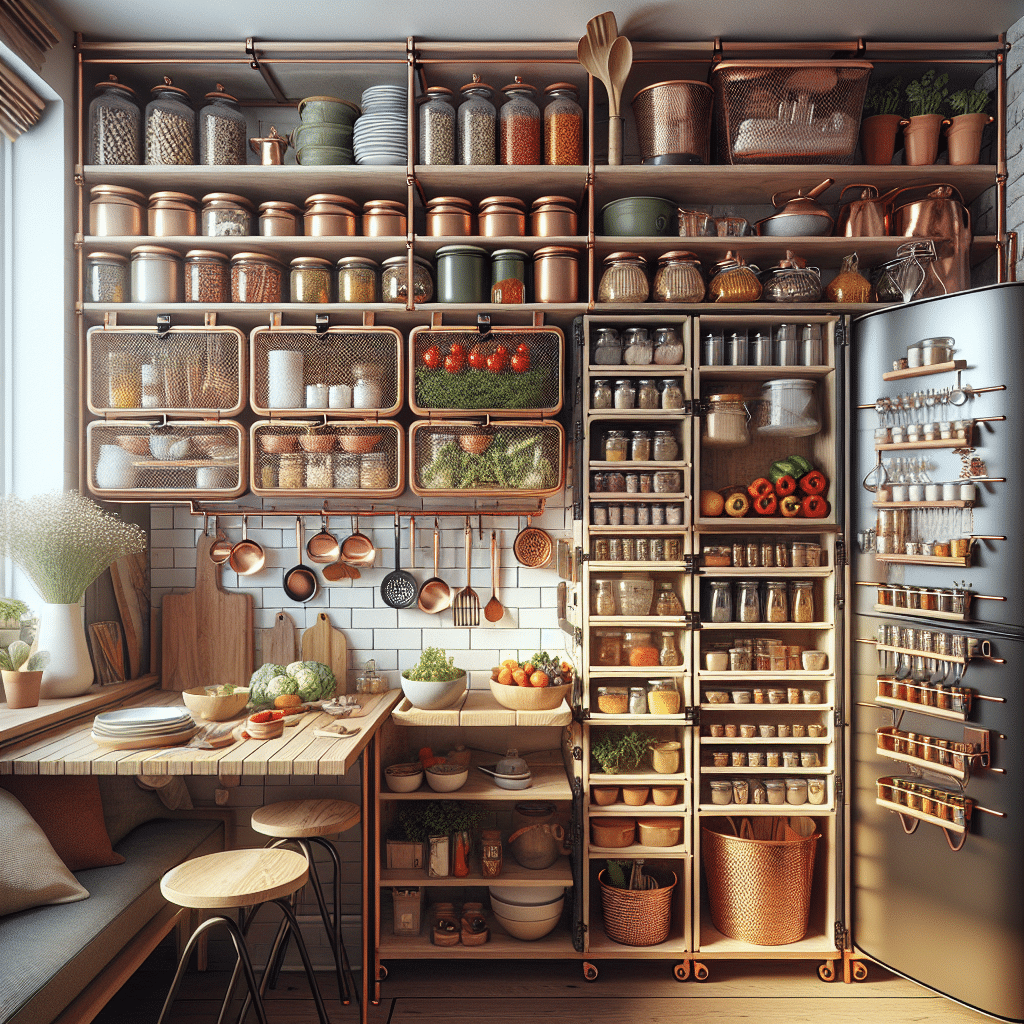Creative Solutions for Tiny Kitchen Storage
1. Utilize Vertical Space
One of the most effective ways to maximize storage in a tiny kitchen is to utilize vertical space. By going upwards instead of outwards, you can free up floor space while gaining accessible storage.
-
Wall-Mounted Shelves: Installing shelves above countertops or in corners can provide additional storage for cookbooks, jars, or decorative items. Floating shelves can create an illusion of additional space and are available in various finishes to complement your kitchen decor.
-
Magnetic Strips: Magnetic strips are not just for knives. They can hold metal utensils like spatulas or canisters, keeping them within arm’s reach while decluttering surfaces.
-
Over-the-Door Racks: Utilize the backs of cabinet doors for extra storage. Small racks or pockets can hold spices, cutting boards, or dish towels, turning dead space into functional areas.
2. Multi-functional Furniture
Opting for multi-functional furniture helps in maximizing space and functionality.
-
Portable Kitchen Islands: A mobile kitchen island can serve as extra counter space and storage. Many come with shelves, drawers, and even seating options, tailored to fit in tight spaces.
-
Drop-Leaf Tables: These tables can be expanded when needed and tucked away when not in use, thereby reducing the footprint when space is limited.
-
Stackable Stools: Choose stools that can be stacked and stored to save space. They can also double as side tables or additional prep space when needed.
3. Invest in Clear Containers
Clear containers not only tidy up but also allow for easy identification.
-
Airtight Glass Jars: These jars are great for storing dry goods, keeping them visible and fresh. Label each jar to maintain organization, and group items by category for easy access.
-
Baskets for Pantries: Baskets can help separate different items in pantries or on shelves. Use labeled wicker or wire baskets to create zones (snacks, baking supplies, canned goods), simplifying the retrieval process and maintaining order.
4. Opt for Slimline Furniture
Choosing slimline furniture pieces can save precious inches in a small kitchen.
-
Narrow Storage Cabinets: Cabinet designs specifically made for tight spaces often come with deep shelves or pull-out drawers, perfect for utilizing narrow openings.
-
Slim Rolling Carts: A rolling cart can fit into narrow gaps and can be moved anywhere in the kitchen. Use it as extra prep space or a place for drinks and snacks when entertaining.
5. Install Hooks and Pegboards
Hooks and pegboards allow for customizable storage solutions.
-
Ceiling Hooks: Consider hanging pots and pans from the ceiling. A well-placed pot rack frees up cabinet space while adding an aesthetic touch.
-
Pegboard Systems: Wall-mounted pegboards can be customized to hold utensils, pots, or kitchen gadgets. Paint them to match your kitchen’s color palette, making them stylish yet functional.
6. Hidden Storage Solutions
Creating hidden storage can add to the kitchen’s aesthetics while maximizing functionality.
-
Pull-Out Drawers: Installing pull-out drawers inside cabinets makes it easy to access items in the back. They are perfect for spices and pantry items that are otherwise difficult to reach.
-
Toe-Kick Drawers: These drawers make use of the often-overlooked space at the bottom of cabinets. They are ideal for flat items, such as baking sheets or cutting boards.
7. Use the Inside of Cabinets Wisely
The insides of cabinet doors can be utilized effectively with a bit of creative thinking.
-
Small Hooks or Clips: Use adhesive hooks inside a cabinet door to hang measuring spoons or kitchen towels.
-
Tiered Shelf Organizers: Install tiered shelves inside deep cabinets to maximize visibility and avoid clutter. Items placed on each tier are easily accessible without needing to dig through.
8. Consider Slim Appliances
Opting for compact appliances helps create a streamlined look.
-
Countertop Appliances: Select hybrid devices that combine functions, such as a toaster oven that can also air fry. These can reduce the number of appliances needed.
-
Under-Counter Refrigerators: Design your kitchen with sleek under-counter fridges to save surface space. They retain the functionality of a standard fridge but with a smaller footprint.
9. Use Dividers and Organizers
Organizers help maintain order inside drawers and cabinets.
-
Drawer Dividers: Installing adjustable dividers in drawers keeps utensils neatly categorized and easy to find. They can prevent clutter and allow quick access.
-
Shelf Risers: Adding shelf risers can serve to double the amount of usable space on shelves, creating a layered look that provides additional storage for dishes and cookware.
10. Optimize Your Pantry
Maximize pantry space with strategic organization.
-
Clear Bins: Similar to clear containers, use bins in various sizes for grains, snacks, and baking ingredients. It makes it easy to spot what you’re looking for and maintains a tidy appearance.
-
Lazy Susans: These rotating trays are perfect for corner cabinets or pantries, allowing easy access to items that would otherwise be hidden.
11. Get Creative with Unused Spaces
Identify areas that could be repurposed for storage.
-
Under the Sink Storage: Use stackable bins or a tiered organizer under the sink for cleaning supplies, maximizing a typically hard-to-access area.
-
Window Sills: In kitchens with deep sills, place herbs or small plants that can serve as both decor and cooking essentials.
12. Keep a Minimalist Approach
Sometimes less is more in a tiny kitchen.
-
Declutter Regularly: Regularly review your kitchen items and remove those that are unnecessary or broken. Aim to keep only what you frequently use to maintain an organized and efficient cooking space.
-
Go for Essential Tools: Invest in high-quality, essential kitchen tools instead of accumulating a multitude of specialized gadgets you might only use once.
By implementing these tiny kitchen storage solutions, you can maximize your limited space while ensuring that the kitchen remains functional, organized, and inviting. Through creativity and practical design, every square inch can become a valuable part of the kitchen experience.
